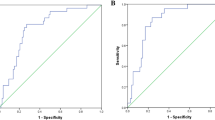Abstract
Background
Postoperative pancreatic fistula remains a troublesome complication after pancreatoduodenectomy (PD), and many authors have suggested factors that affect pancreatic leakage after PD. The International Study Group on Pancreatic Fistula (ISGPF) published a classification, but the new criteria adopted have not been substantially validated. The aims of this study were to validate the ISGPF classification and to analyze the risk factors of pancreatic leakage after duct-to-mucosa pancreatojejunostomy by a single surgeon.
Methods
All patient data were entered prospectively into a database. The risk factors for pancreatic fistula were analyzed retrospectively for 247 consecutive patients who underwent conventional pancreatoduodenectomy or pylorus-preserving pancreatoduodenectomy between June 2005 and March 2009 at the Samsung Medical Center by a single surgeon. Duct-to-mucosa pancreatojejunostomy was performed on all patients. The ISGPF criteria were used to define postoperative pancreatic fistula.
Results
Conventional pancreatoduodenectomy was performed in 84 patients and pylorus-preserving pancreatoduodenectomy in 163. Postoperative complications occurred in 144 (58.3%) patients, but there was no postoperative in-hospital mortality. Pancreatic fistula occurred in 105 (42.5%) [grade A, 82 (33.2%); grade B, 9 (3.6%); grade C, 14 (5.7%)]. However, no difference was evident between the no fistula group and the grade A fistula group in terms of clinical findings, including postoperative hospital stays (11 versus 12 days, respectively, p = 0.332). Mean durations of hospital stay in the grade B and C fistula groups were significantly longer than in the no fistula group (21 and 28.5 days, respectively; p < 0.001). Multivariate analysis revealed that a soft pancreas and a long operation time (>300 min) were individually associated with pancreatic fistula formation of grades B and C.
Conclusions
Although the new ISGPF classification appears to be sound in terms of postoperative pancreatic leakage, grade A fistulas lack clinical implications; thus, we are of the opinion that only grade B and C fistulas should be considered in practice. A soft pancreatic texture and an operation time exceeding 300 min were found to be risk factors of grade B and C pancreatic fistulas.
Similar content being viewed by others
References
Shrikhande SV, Barreto G, Shukla PJ. Pancreatic fistula after pancreaticoduodenectomy: the impact of a standardized technique of pancreaticojejunostomy. Langenbecks Arch Surg 2008;393:87–91.
Schmidt CM, Powell ES, Yiannoutsos CT, Howard TJ, Wiebke EA, Wiesenauer CA, Baumgardner JA, Cummings OW, Jacobson LE, Broadie TA, Canal DF, Goulet RJ, Jr., Curie EA, Cardenes H, Watkins JM, Loehrer PJ, Lillemoe KD, Madura JA. Pancreaticoduodenectomy: a 20-year experience in 516 patients. Arch Surg 2004;139:718–725; discussion 725–727.
Pratt WB, Maithel SK, Vanounou T, Huang ZS, Callery MP, Vollmer CM, Jr. Clinical and economic validation of the International Study Group of Pancreatic Fistula (ISGPF) classification scheme. Ann Surg 2007;245:443–451.
Bassi C, Dervenis C, Butturini G, Fingerhut A, Yeo C, Izbicki J, Neoptolemos J, Sarr M, Traverso W, Buchler M. Postoperative pancreatic fistula: an international study group (ISGPF) definition. Surgery 2005;138:8–13.
Frymerman AS, Schuld J, Ziehen P, Kollmar O, Justinger C, Merai M, Richter S, Schilling MK, Moussavian MR. Impact of postoperative pancreatic fistula on surgical outcome--the need for a classification-driven risk management. J Gastrointest Surg 2010;14:711–718.
Fuks D, Piessen G, Huet E, Tavernier M, Zerbib P, Michot F, Scotte M, Triboulet JP, Mariette C, Chiche L, Salame E, Segol P, Pruvot FR, Mauvais F, Roman H, Verhaeghe P, Regimbeau JM. Life-threatening postoperative pancreatic fistula (grade C) after pancreaticoduodenectomy: incidence, prognosis, and risk factors. Am J Surg 2009;197:702–709.
Buchler MW, Friess H, Wagner M, Kulli C, Wagener V, Z'Graggen K. Pancreatic fistula after pancreatic head resection. Br J Surg 2000;87:883–889.
Marcus SG, Cohen H, Ranson JH. Optimal management of the pancreatic remnant after pancreaticoduodenectomy. Ann Surg 1995;221:635–645; discussion 645–648.
Suc B, Msika S, Fingerhut A, Fourtanier G, Hay JM, Holmieres F, Sastre B, Fagniez PL. Temporary fibrin glue occlusion of the main pancreatic duct in the prevention of intra-abdominal complications after pancreatic resection: prospective randomized trial. Ann Surg 2003;237:57–65.
Khan AW, Agarwal AK, Davidson BR. Isolated Roux Loop duct-to-mucosa pancreaticojejunostomy avoids pancreatic leaks in pancreaticoduodenectomy. Dig Surg 2002;19:199–204.
Batignani G, Fratini G, Zuckermann M, Bianchini E, Tonelli F. Comparison of Wirsung-jejunal duct-to-mucosa and dunking technique for pancreatojejunostomy after pancreatoduodenectomy. Hepatobiliary Pancreat Dis Int 2005;4:450–455.
Ohwada S, Tanahashi Y, Ogawa T, Kawate S, Hamada K, Tago KI, Yamada T, Morishita Y. In situ vs ex situ pancreatic duct stents of duct-to-mucosa pancreaticojejunostomy after pancreaticoduodenectomy with billroth I-type reconstruction. Arch Surg 2002;137:1289–1293.
Asopa HS, Garg M, Singhal GG, Singh L, Asopa J. Pancreaticojejunostomy with invagination of spatulated pancreatic stump into a jejunal pouch. Am J Surg 2002;183:138–141.
Okamoto A, Tsuruta K. Fistulation method: simple and safe pancreaticojejunostomy after pancreatoduodenectomy. Surgery 2000;127:433–438.
Tsuji M, Kimura H, Konishi K, Yabushita K, Maeda K, Kuroda Y. Management of continuous anastomosis of pancreatic duct and jejunal mucosa after pancreaticoduodenectomy: historical study of 300 patients. Surgery 1998;123:617–621.
Poon RT, Fan ST, Lo CM, Ng KK, Yuen WK, Yeung C, Wong J. External drainage of pancreatic duct with a stent to reduce leakage rate of pancreaticojejunostomy after pancreaticoduodenectomy: a prospective randomized trial. Ann Surg 2007;246:425–433; discussion 433–435.
Mathur A, Pitt HA, Marine M, Saxena R, Schmidt CM, Howard TJ, Nakeeb A, Zyromski NJ, Lillemoe KD. Fatty pancreas: a factor in postoperative pancreatic fistula. Ann Surg 2007;246:1058–1064.
Author information
Authors and Affiliations
Corresponding author
Rights and permissions
About this article
Cite this article
Kim, W.S., Choi, D.W., Choi, S.H. et al. Clinical Validation of the ISGPF Classification and the Risk Factors of Pancreatic Fistula Formation Following Duct-to-Mucosa Pancreaticojejunostomy by One Surgeon at a Single Center. J Gastrointest Surg 15, 2187–2192 (2011). https://doi.org/10.1007/s11605-011-1726-0
Received:
Accepted:
Published:
Issue Date:
DOI: https://doi.org/10.1007/s11605-011-1726-0




